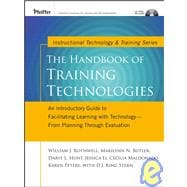
Marilynn N. Butler, Ph.D., is dean of the School of Professional Studies and associate professor of business and human resources, Ursuline College, Pepper Pike, Ohio.
Daryl L. Hunt, Ph.D., is an information management consultant for MatrixOne Inc.
Jessica Li, Ph.D., is a clinical assistant professor in the department of education administration and human resource development at Texas A&M University, College Station, Texas.
Cecilia Maldonado, Ph.D., is an assistant professor at the University of Nevada, Las Vegas, in the department of educational leadership.?
Karen Peters, Ph.D., is the manager of instructional design at the Pennsylvania State University.
|
|||
|
|||
|
|||
|
|||
|
|||
| PART 1. GETTING STARTED WITH TECHNOLOGY-ASSISTED TRAINING. | |||
|
|||
|
|||
|
|||
|
|||
|
|||
|
|||
|
|||
|
|||
|
|||
|
|||
|
|||
|
|||
|
|||
|
|||
|
|||
|
|||
|
|||
|
|||
|
|||
|
|||
|
|||
|
|||
| PART 2. DESIGNING AND DEVELOPING TECHNOLOGY-ASSISTED TRAINING. | |||
|
|||
|
|||
|
|||
|
|||
|
|||
|
|||
|
|||
|
|||
|
|||
|
|||
|
|||
|
|||
|
|||
|
|||
|
|||
|
|||
|
|||
|
|||
|
|||
|
|||
|
|||
|
|||
|
|||
|
|||
|
|||
|
|||
|
|||
|
|||
| PART 3. DELIVERING TECHNOLOGY-ASSISTED TRAINING. | |||
|
|||
|
|||
|
|||
|
|||
|
|||
|
|||
|
|||
|
|||
|
|||
|
|||
|
|||
|
|||
|
|||
|
|||
|
|||
|
|||
|
|||
|
|||
|
|||
|
|||
|
|||
|
|||
|
|||
|
|||
|
|||
|
|||
|
|||
|
|||
| PART 4. ASSESSING AND EVALUATING TECHNOLOGY-ASSISTED TRAINING. | |||
|
|||
|
|||
|
|||
|
|||
|
|||
|
|||
|
|||
|
|||
|
|||
|
|||
|
|||
|
|||
|
|||
|
|||
|
|||
|
|||
|
|||
|
|||
|
|||
|
|||
|
|||
|
|||
|
|||
|
|||
|
|||
| PART 5. PLANNING FOR THE FUTURE OF TECHNOLOGY-ASSISTED TRAINING. | |||
|
|||
|
|||
|
|||
|
|||
|
|||
|
|||
|
|||
|
|||
|
|||
|
|||
|
|||
|
|||
|
|||
|
|||
|
|||
|
The New copy of this book will include any supplemental materials advertised. Please check the title of the book to determine if it should include any access cards, study guides, lab manuals, CDs, etc.
The Used, Rental and eBook copies of this book are not guaranteed to include any supplemental materials. Typically, only the book itself is included. This is true even if the title states it includes any access cards, study guides, lab manuals, CDs, etc.